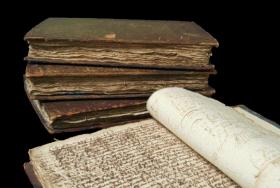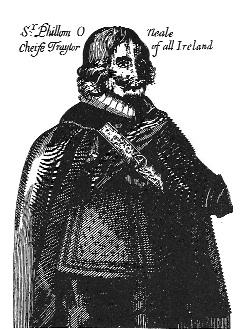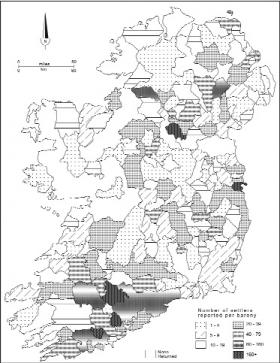Anatomy of plantation: the 1641 Depositions
Published in 1641 Rebellion, Early Modern History (1500–1700), Early Modern History Social Perspectives, Features, General, Issue 6 (Nov/Dec 2009), Volume 17
There are 4,000 depositions (20,000 pages) or witness statements, examinations and associated materials, bound in 31 volumes, in the archives of Trinity College, Dublin. The eight Ulster volumes contain a total of 1,559 depositions, 344 of them by women. (Trinity College, Dublin)
What are they?
The 1641 Depositions are witness testimonies by mainly Protestant men and women, from all social backgrounds, concerning their experiences of the 1641 Irish rebellion. The testimonies document losses of goods and chattels, military activity and the alleged crimes of the Catholic Irish rebels, including assault, imprisonment, the stripping of clothes and murder. This body of material is unparalleled anywhere in early modern Europe and provides a unique source of information for the causes and events surrounding the 1641 rebellion, and for the social, economic, cultural, religious and political history of seventeenth-century Ireland, England and Scotland.
There are two types of deposition: the statements taken down within a year or two of the events they describe and those collected during the 1650s, principally as evidence against defeated rebels. The earlier ones are more-or-less spontaneous reports; the later ones, though they contain much of value, are more formulaic and depend on the quality of a deponent’s memory. In all, nearly 4,000 depositions (20,000 pages) or witness statements, examinations and associated materials, bound in 31 volumes, are extant in the archives of Trinity College, Dublin. They are difficult to read (some are virtually illegible); the spelling is inconsistent and erratic, as is the use of grammar and punctuation. Eleven volumes contain depositions relating to Leinster, ten to Munster (seven of these cover County Cork), two to Connacht and eight to Ulster. The Ulster volumes contain a total of 1,559 depositions, 344 of them by women. Commissioners collected the depositions relating to counties Antrim and Down in the early 1650s, whereas all of the depositions taken in County Cavan date from the 1640s. The remaining Ulster counties contain a chronological spread across the two decades.
Certain information was standard to each deposition. The name and address of the deponent was always recorded, and in many instances the occupation and age also appear. If capable of writing, the deponent usually signed (or left a mark on) his statement, as did the commissioners who committed the oral testimony to paper. The table below provides a detailed breakdown of the twenty depositions relating to County Londonderry, by fifteen men and five women, which were collected between February 1642 and August 1653. From the surnames it appears that the bulk of the deponents were of English extraction (Moore, Nixon, Smyth), but others were probably Scottish (Ervine, Fergusson, Graham) and a few were probably native Irish and Catholic (O’Laverty, MacGahern). All but four deponents indicated their occupation. The women described themselves as widows or wives; five of the men were gentlemen and three were soldiers; then there was a clerk, a husbandman, a tanner and a weaver. Only four men gave their ages. A high proportion (ten people, two women and eight men) signed their names, suggesting some level of literacy, and six left a mark.
Settlement patterns

Sir Phelim O’Neill, one of the leaders of the rebellion, allegedly chastised George Creighton, a minister and a Scotsman who had settled in Virginia, Co. Cavan, for bringing ‘Plantacions into our Landes’.
The depositions constitute the chief evidence for the sharply contested allegation that the rebellion began with a general massacre of Protestant settlers but are also invaluable sources for the history of the late sixteenth- and early seventeenth-century plantations and other expropriations. Material in the depositions vividly recaptures these land transfers and the settlement patterns of the newcomers as they built fortified mansions, villages, schools and churches; cut down woods and drained and enclosed land; and nurtured the development of urban settlements and proto-industry (tanning, iron-making, glass-making, cloth-making and so on). The testimonies in the depositions also bear witness to the extent to which the Crown had managed to ‘civilise’ and ‘Anglicise’ Ireland. For at the heart of any colonial venture was the long-held determination to impose on Ireland an English legal, political, administrative, tenurial and honour system, together with the English language and religion (Protestantism), English ‘civility’—dress, customs, codes of behaviour—and English (lowland) economic and agricultural practices. The depositions vividly recapture the extent to which the English system of landlord–tenant relations and a lowland commercial economy had become established in Ireland by 1641, as well as how individual landlords had improved their lands by promoting tillage, maximised profits from their mills, exploited the estate’s natural resources and introduced new breeds of cattle.
A handful of depositions specifically mention the plantations as a cause of the 1641 rebellion. Sir Phelim O’Neill, one of the leaders of the 1641 rebellion, allegedly chastised George Creighton, a minister and a Scotsman who had settled in Virginia, Co. Cavan, for bringing ‘Plantacions into our Landes’ (TCD, MS 833, f. 233). A gentleman from County Monaghan, Alexander Creichton, overheard the insurgents ‘say they wold never lay downe arms, till their church were putt into its due place, and that all the plantacion Landes were given to the right owners’ (TCD, MS 834, f. 109v). This is precisely what happened elsewhere. On 22 September 1642 William Baxter, a gentleman from County Fermanagh, swore that Ross McArt McGuire seized his lands at Rathmoran, c. 1,000 acres with an annual rental of £200, in County Fermanagh on the grounds that they ‘belonged to his father before the said plantation’. Baxter also listed his other losses, which illustrate how prosperous he was: twenty horses and mares worth £210; ‘howsehould Stuffe’ worth £40; corn (in the field and in the barn) worth £110; and ‘30 li. of debts & areares of rent’ (TCD, MS 835, f. 192).
Some of the deponents described how an individual or their parents had settled in Ulster during the early decades of the seventeenth century. For example, on 19 July 1643 Francis Leiland, a yeoman from County Armagh, swore that:
‘hee this deponent hath lived within the parrish & Countie of Armaghe for the space of thirty yeres together last past [i.e. since 1613] and above & by that meanes very well knew the Cuntry & many of the Cuntry people thereabouts: And is verely perswaded that when the present Rebellion begun there were of the English and Scotts protestants dwelling within the two parrishes of Armagh and Logghall the number of eight thowsand at the Least men women and children protestants the most of which the deponent is verely perswaded were murthered & putt to death by the Rebells, by drowning burning hanging starveing the sword & by other cruell deaths and torments; & that but a very few escaped’.
Leiland went on to recount the ‘distruccion & the burning of the Churches of Armagh & towne & of Castle dillon & other howses Castles & buildinges most of which this deponent saw on fyre by the Rebells those braue Rojall [royal] plantacions there are quite demolished wasted & of all the former Inhabitants (saveing the base irish) depopulated’ (TCD, MS 836, f. 98v). Vivid though Leiland’s account was, his figures for those who had settled in Armagh and subsequently perished there were grossly exaggerated. Recent research on deaths in County Armagh, where some of the worst atrocities did occur, suggests that between 600 and 1,300 settlers actually died (or between 10.5 and 25 per cent of the total settler population of 5,000).
Income and material culture

Geographical distribution of settlers by barony, as reported in the 1641 Depositions. (W. J. Smyth, Map-making, landscape and memory: a geography of colonial and early modern Ireland c. 1530–1750, Cork University Press, 2006)
Bearing in mind their biases, the 1641 Depositions nevertheless reveal much about pre-war settlement patterns, and from this it is possible to determine the numbers of craftsmen and skilled workmen resident on a lord’s estate or in a neighbouring town. For example, during the early decades of the seventeenth century, the Scottish planter Andrew Stewart, Lord Ochiltree (later Baron Castlestewart), oversaw the growth of Stewartstown, Co. Tyrone, into a proto-industrial settlement of three gentlemen, 24 tradesmen—a ditcher, shoemaker, tailor, carpenter, butcher, malt-maker and some weavers—and a schoolmaster. The 1641 Depositions also provide an invaluable, albeit impressionistic, insight into pre-war levels of income and material culture. For example, Lord Blayney deposed on 11 July 1643 that he lost his castle at Blayney in County Monaghan, together with goods and riding horses worth £237, plate (£500), linen (£500), and beasts, cattle and sheep (£925). There was ‘More howsholdstuff in his 2 howses worth at least 1000 markes, ready money £296, due debts £400, a library of bookes worth £500’, besides other things that he could not recall. In all, Blayney estimated that the insurgents had inflicted £13,873–8–4 worth of damage on his property, goods and livestock, and that he had lost an annual rental of £2,250 (TCD, MS 834, f. 74v). The family had come a long way in just two generations. Back in 1604 the king had rewarded his father, Sir Edward Blayney, a Welsh soldier who had served in Ireland during the Nine Years’ War, with 2,000 acres provided that he built a castle for ‘relief of Monaghan’. Within a decade Blayney had built his castle, fortified the town and secured the region for the Crown. Gaelic landownership persisted longer in Monaghan than in other Ulster counties, yet Blayney’s estates continued to grow as the family speculated in land, and by 1641 they amounted to 24,572 plantation acres centred on the baronies of Cremore, Dartree and Monaghan. Given their strategic importance, it is little wonder that the insurgents seized the town and targeted the castles of Monaghan and Blayney. HI
Jane Ohlmeyer is Erasmus Smith’s Professor of Modern History at Trinity College, Dublin.
Further reading:
N. Canny, ‘The 1641 depositions: a source for social and cultural history’, History Ireland 1.4 (1993).
N. Canny, Making Ireland British 1580–1650 (Oxford, 2001).
A. Clarke, ‘The genesis of the Ulster rising of 1641’, in P. Roebuck (ed.), Plantation to partition: essays in Ulster history (Belfast, 1981).
A. Clarke, ‘The 1641 depositions’, in P. Fox (ed.), Treasures of the library: Trinity College, Dublin (Dublin, 1986).
















